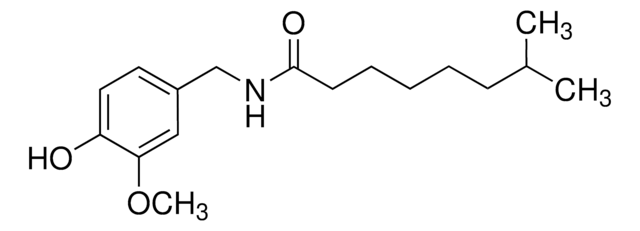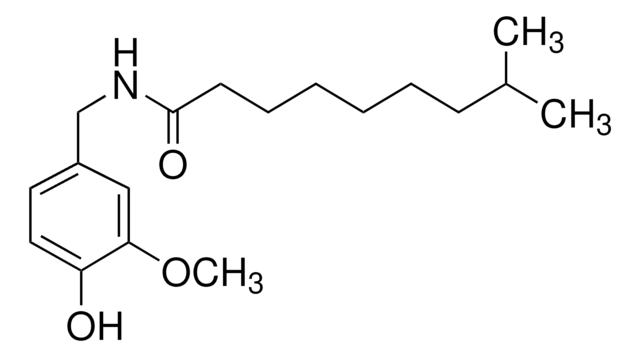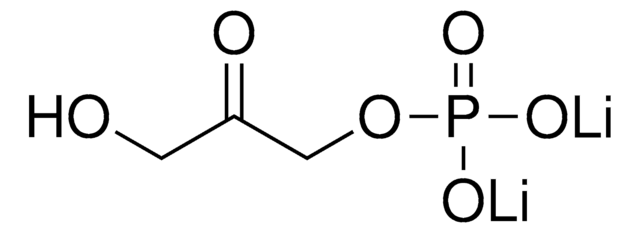推薦產品
等級
pharmaceutical primary standard
agency
EP Reference Standard
API 家族
capsaicin
製造商/商標名
EDQM
mp
62-65 °C (lit.)
應用
pharmaceutical (small molecule)
形式
neat
儲存溫度
2-8°C
SMILES 字串
COc1cc(CNC(=O)CCCC\C=C\C(C)C)ccc1O
InChI
1S/C18H27NO3/c1-14(2)8-6-4-5-7-9-18(21)19-13-15-10-11-16(20)17(12-15)22-3/h6,8,10-12,14,20H,4-5,7,9,13H2,1-3H3,(H,19,21)/b8-6+
InChI 密鑰
YKPUWZUDDOIDPM-SOFGYWHQSA-N
基因資訊
human ... TRPV1(7442)
尋找類似的產品? 前往 產品比較指南
一般說明
This product is provided as delivered and specified by the issuing Pharmacopoeia. All information provided in support of this product, including SDS and any product information leaflets have been developed and issued under the Authority of the Issuing Pharmacopoeia. For further information and support please go to the website of the issuing Pharmacopoeia.
應用
Capsaicin EP Reference standard, intended for use in laboratory tests only as specifically prescribed in the European Pharmacopoeia.
生化/生理作用
原型香草受体激动剂。 神经毒素;激活产生无髓C纤维的感觉神经元,其中许多含有P物质。 局部使用可使感觉神经末梢脱敏,从而产生反常的抗伤害感受作用;全身给药可对辣椒素敏感的细胞产生神经毒性,尤其是在新生动物中。辣椒的活性成分。
包裝
The product is delivered as supplied by the issuing Pharmacopoeia. For the current unit quantity, please visit the EDQM reference substance catalogue.
其他說明
Sales restrictions may apply.
訊號詞
Danger
危險分類
Acute Tox. 2 Oral - Eye Dam. 1 - Resp. Sens. 1 - Skin Irrit. 2 - Skin Sens. 1 - STOT SE 3
標靶器官
Respiratory system
儲存類別代碼
6.1A - Combustible acute toxic Cat. 1 and 2 / very toxic hazardous materials
水污染物質分類(WGK)
WGK 3
閃點(°F)
235.4 °F - closed cup
閃點(°C)
113 °C - closed cup
客戶也查看了
Jennifer Leech et al.
American journal of respiratory and critical care medicine, 188(9), 1069-1075 (2013-10-08)
Antitussive therapies are accompanied by a substantial placebo effect, indicating that inhibitory circuits in the brain have a significant capacity to regulate cough neural processing. However, essentially nothing is known about the identity of these inhibitory circuits or how they
Zohar Bromberg et al.
PloS one, 8(2), e57149-e57149 (2013-03-08)
The heat shock response (HSR) is a highly conserved molecular response to various types of stresses, including heat shock, during which heat-shock proteins (Hsps) are produced to prevent and repair damages in labile proteins and membranes. In cells, protein unfolding
Emma C Y Hilton et al.
The Journal of allergy and clinical immunology, 132(4), 847-855 (2013-06-20)
Inhaled capsaicin elicits cough reproducibly in human subjects and is widely used in the study of cough and antitussive therapies. However, the traditional end points C2 and C5 (the concentrations of capsaicin inducing at least 2 or 5 coughs, respectively)
Helen Sumner et al.
American journal of respiratory and critical care medicine, 187(9), 943-949 (2013-03-09)
Cough is one of the principal symptoms of chronic obstructive pulmonary disease (COPD) but the potential drivers of cough are likely to be multifactorial and poorly understood. To quantify cough frequency in an unselected group of subjects with COPD and
Jessica O'Neill et al.
Pharmacological reviews, 64(4), 939-971 (2012-10-02)
A large number of pharmacological studies have used capsaicin as a tool to activate many physiological systems, with an emphasis on pain research but also including functions such as the cardiovascular system, the respiratory system, and the urinary tract. Understanding
我們的科學家團隊在所有研究領域都有豐富的經驗,包括生命科學、材料科學、化學合成、色譜、分析等.
聯絡技術服務









